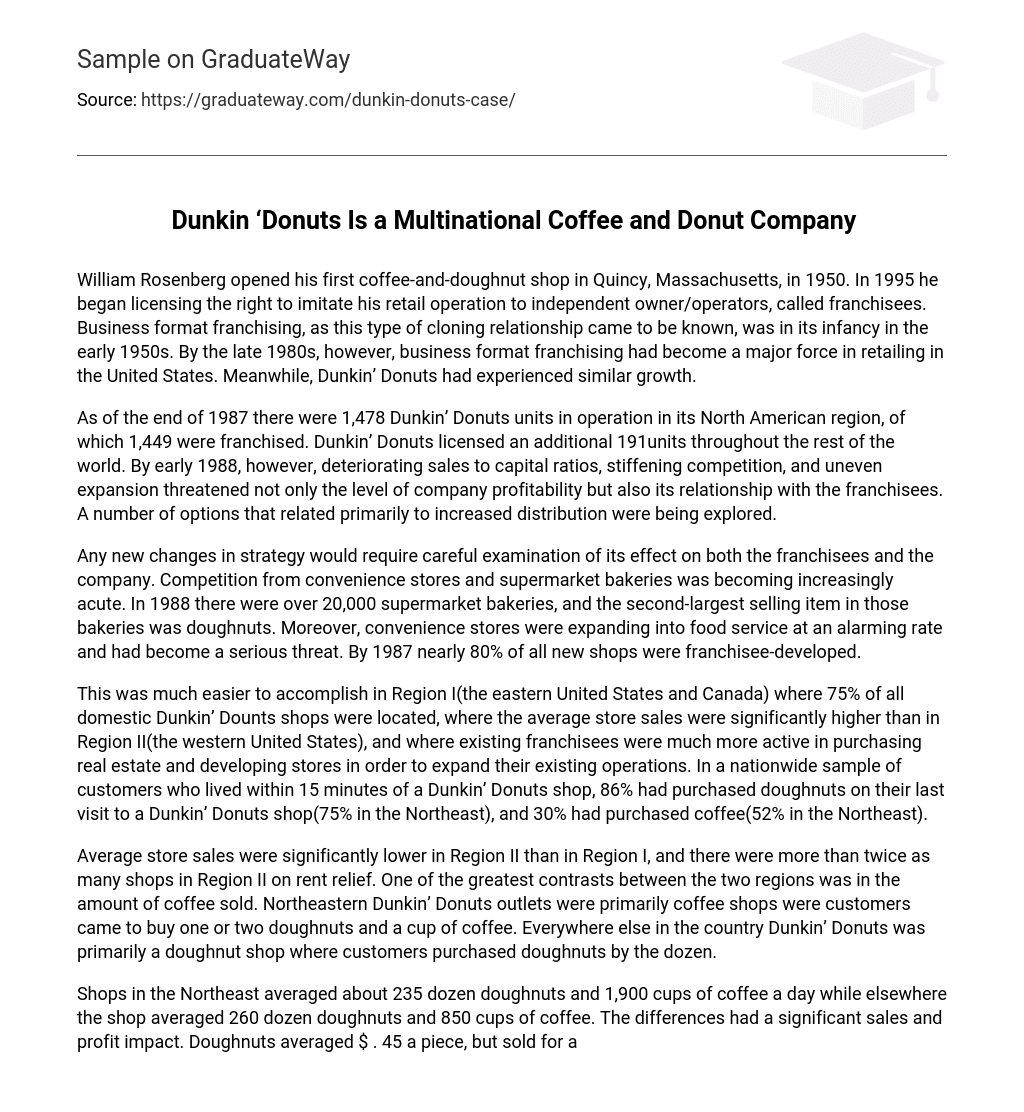William Rosenberg launched his inaugural coffee-and-doughnut store in Quincy, Massachusetts, in 1950. In 1995, he initiated the process of granting licenses to independent owner/operators, referred to as franchisees, to replicate his retail business model. This form of cloning relationship was coined as business format franchising and was still in its early stages in the early 1950s. By the late 1980s, business format franchising had gained significant prominence in the retail sector in the United States. Simultaneously, Dunkin’ Donuts also witnessed similar expansion.
As of the end of 1987, Dunkin’ Donuts had a total of 1,478 units in operation in its North American region. Out of these, 1,449 were franchised. Additionally, Dunkin’ Donuts had licensed 191 units in other parts of the world. However, by early 1988, the company faced challenges such as declining sales to capital ratios, increased competition, and uneven expansion. These factors not only affected the company’s profitability but also its relationship with franchisees. Various options, mainly focusing on expanding distribution, were being considered.
When considering modifications to the strategy, it is crucial to assess the impact it would have on both the franchisees and the company. The competition from convenience stores and supermarket bakeries was growing more intense. By 1988, there were more than 20,000 supermarket bakeries, with doughnuts being the second-most popular item sold. Additionally, convenience stores were rapidly expanding into food service and posed a significant threat. Furthermore, by 1987, franchisee-developed shops accounted for nearly 80% of all new establishments.
In the eastern United States and Canada (Region I), most Dunkin’ Donuts shops had higher average store sales compared to the western United States (Region II). Franchisees in Region I were more active in expanding by purchasing real estate and developing stores. In a nationwide sample, 86% of customers who lived within 15 minutes of a Dunkin’ Donuts shop had bought doughnuts on their last visit (with 75% being in the Northeast), while 30% had purchased coffee (with 52% being in the Northeast).
In Region I, sales were higher compared to Region II. Additionally, there were more than double the number of shops on rent relief in Region II. The primary difference between the two regions was the focus on coffee sales. In the Northeastern region’s Dunkin’ Donuts outlets, coffee took precedence and customers typically bought a few doughnuts along with their coffee. Conversely, in all other parts of the country, Dunkin’ Donuts primarily operated as a doughnut shop where customers would purchase larger quantities of doughnuts.
The average daily sales of doughnuts and coffee differed between shops in the Northeast and elsewhere. In the Northeast, shops sold about 235 dozen doughnuts and 1,900 cups of coffee per day, while shops in other locations averaged 260 dozen doughnuts and 850 cups of coffee. These differences had a significant impact on sales and profits. A single doughnut was priced at $0.45, but when sold in dozens, it was approximately $3.00. Coffee was also a high-margin item. Franchisees contributed 5% of their gross sales to an Advertising and Promotion Fund. Due to the uneven distribution of Dunkin’ Donuts shops across the nation, there was no national media advertising purchased. Instead, all television and radio ads were conducted on a market or regional basis.
Dunkin’ Donuts is dedicating approximately 20% of its advertising budget to promote new products such as sandwiches. The goal is to decrease their dependence on doughnuts and create demand throughout the entire day. To tackle the issues of declining sales growth, heightened competition, and a deteriorating sales-to-capital ratio, both the company and its franchisees acknowledge the necessity for a fresh growth strategy. This may entail attracting more sophisticated franchisees or streamlining marketing programs and production processes.
Three different approaches were adopted: developing new and/or previously untapped markets, selling branded products through convenience stores, and opening non-producing retail outlets. Dunkin’ Donuts’ corporate policy was to thoroughly test all new strategies before requiring franchisees to implement them. Some managers preferred expanding distribution by opening new stores in less saturated markets, either through targeted company development or area franchising.
However, Dunkin’Donuts would likely need to play an active role in developing the real estate for the different sites in order to implement such a strategy. Some managers suggested that Dunkin’Donuts could partner with convenience store chains to provide their branded products to participating outlets. The proposal included an expectation that a local franchisee would deliver fresh Dunkin’Donuts products to approximately 10 to 15 convenience stores twice daily. It was assumed that the franchisees would rent the delivery vehicles and that no additional franchise fee would be required.
Satellites were used by Dunkin’Donuts management to tap into consumer demand in markets where an extra producing unit wouldn’t be feasible. These nonproducing units, such as storefronts, shopping mall stalls, or train station carts, were serviced by nearby full-producing units. This strategy aimed to prevent competitors from entering those locations.
Tom Schwarz, president of Dunkin’Donuts, expressed his viewpoint on the present circumstance. He recognized that persuading individuals to consume more doughnuts may not be possible; however, he held the belief that by providing a broader selection of choices, they could attract a larger clientele. Schwarz emphasized that there is still potential for enhancement.





